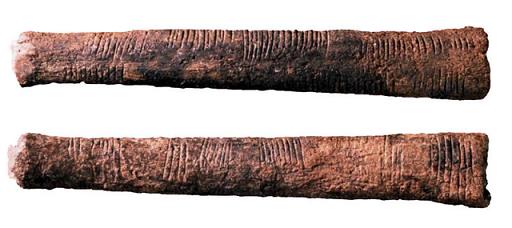Copyright © University of Cambridge. All rights reserved.
'Ishango Bone' printed from https://nrich.maths.org/
Show menu
In 1960, a strange bone cutting tool was discovered during the excavation of a prehistoric site in Zaire.

On the bone tool are a series of markings arranged in regular patterns. They appear to exhibit a lot of possible mathematical structure. There are three rows of markings; on each row the markings are grouped into clusters as follows:
Row A: $19, 17, 13, 11$
Row B: $7, [5, 5, 1, 9], 8, 4, [6, 3]$ (we are not sure how the scratches in the brackets were grouped)
Row C: $9, 19, 21, 11$
(In row B, the groupings of some of the scratches is not very clear: the $[5, 5, 1, 9]$ part might also be $[10, 10]$ or $[10, 1, 9]$ or $[5, 5, 10]$. Similarly, the $[6, 3]$ scratchings might be grouped into $[9]$ .)
Investigate these numbers and their properties.
Do you think that they are just random, or can you see any patterns?
How do you think that the scratchings should be grouped?
Can you create a hypothesis as to the meaning of the scratches or why they might have been made?
Why are you making a hypothesis and not a proof?
Would it ever be possible to be certain of the meanings of the scratches?
Imagine that you find another similar bone which was created according to your rules. What different patterns of scratches could it exhibit?
This bone is around 20,000 years old and is one of the oldest known artefacts exhibiting mathematical structure. Although there are many theories about the meaning of the scratches nobody knows for sure what their purpose is. Perhaps if another similar artefact were found in reality then evidence for the different sorts of hypotheses would grow. It might even be that you will come up with a really clear explanation of all of the scratches which nobody has yet thought about!
You might like to read about this artefact on the wikipedia, from which the images were taken.
Another interesting mathematical artefact, which has a more convinving explanation, is analysed in the problem Babylon Numbers.